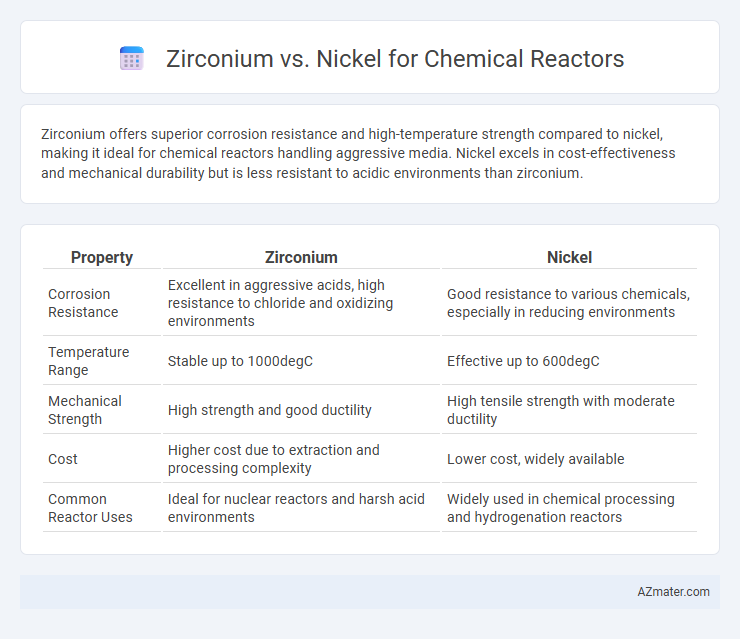Zirconium offers superior corrosion resistance and high-temperature strength compared to nickel, making it ideal for chemical reactors handling aggressive media. Nickel excels in cost-effectiveness and mechanical durability but is less resistant to acidic environments than zirconium.
Table of Comparison
| Property | Zirconium | Nickel |
|---|---|---|
| Corrosion Resistance | Excellent in aggressive acids, high resistance to chloride and oxidizing environments | Good resistance to various chemicals, especially in reducing environments |
| Temperature Range | Stable up to 1000degC | Effective up to 600degC |
| Mechanical Strength | High strength and good ductility | High tensile strength with moderate ductility |
| Cost | Higher cost due to extraction and processing complexity | Lower cost, widely available |
| Common Reactor Uses | Ideal for nuclear reactors and harsh acid environments | Widely used in chemical processing and hydrogenation reactors |
Introduction to Chemical Reactor Materials
Zirconium and nickel are critical materials in chemical reactor construction due to their corrosion resistance and mechanical strength under high-temperature and high-pressure conditions. Zirconium excels in aggressive acidic environments, especially with chloride ions, thanks to its stable oxide film, while nickel-based alloys offer superior resistance to oxidation and sulfidation in hydrocarbon processing. Selection between zirconium and nickel depends on specific reactor environments, process chemicals, and temperature ranges to ensure longevity and operational safety.
Overview of Zirconium and Nickel Properties
Zirconium offers exceptional corrosion resistance and high thermal stability, making it ideal for chemical reactors handling aggressive acids or high-temperature environments. Nickel excels in mechanical strength and oxidation resistance, particularly in environments with alkaline or reducing media. Both metals provide unique advantages in reactor design, with zirconium preferred for its inert surface and nickel valued for durability and catalytic compatibility.
Corrosion Resistance: Zirconium vs Nickel
Zirconium exhibits superior corrosion resistance compared to nickel, particularly in highly aggressive environments such as strong acids and chloride-containing solutions, making it ideal for chemical reactors handling corrosive media. Nickel alloys, while durable and resistant to oxidation, tend to suffer from localized corrosion like pitting and stress corrosion cracking in chloride-rich or acidic conditions. The enhanced passive oxide layer on zirconium provides exceptional protection, ensuring longer equipment lifespan and reduced maintenance costs in corrosive chemical reactor applications.
Temperature Stability and Heat Resistance
Zirconium exhibits superior temperature stability and heat resistance compared to nickel, making it ideal for chemical reactors operating at high temperatures up to 1200degC. Zirconium's exceptional corrosion resistance and low thermal neutron absorption enhance its performance in aggressive reactor environments, whereas nickel alloys typically endure temperatures up to 1000degC but may suffer degradation under prolonged thermal stress. The high melting point of zirconium (1855degC) versus nickel's 1455degC further underscores zirconium's advantage in maintaining mechanical integrity and structural stability in extreme thermal conditions.
Mechanical Strength and Durability Comparison
Zirconium exhibits superior corrosion resistance and excellent mechanical strength at high temperatures, making it ideal for chemical reactor applications involving aggressive environments like acidic or chloride-rich solutions. Nickel offers high tensile strength and good ductility, maintaining mechanical integrity under thermal stress but may suffer from localized corrosion in harsh chemical conditions. Zirconium's durability in maintaining structural stability under prolonged exposure to corrosive agents often surpasses Nickel, ensuring longer service life and reduced maintenance in reactor operations.
Cost Analysis: Zirconium vs Nickel
Zirconium's cost in chemical reactors is generally higher due to its scarcity and complex extraction process compared to nickel, which is more abundant and economical. Despite nickel's lower cost, zirconium offers superior corrosion resistance in aggressive chemical environments, potentially reducing maintenance expenses and downtime. Evaluating total lifecycle costs, including material, installation, and long-term operational efficiency, often positions zirconium as cost-effective for highly corrosive reactor applications.
Compatibility with Chemical Processes
Zirconium exhibits superior corrosion resistance in highly acidic and chloride-rich environments, making it ideal for chemical reactors dealing with aggressive chemicals such as sulfuric acid and hydrochloric acid. Nickel alloys demonstrate excellent compatibility with high-temperature oxidative and reducing conditions, commonly found in processes involving steam reforming and petrochemical synthesis. Selecting between zirconium and nickel hinges on the reactor's specific chemical exposure, temperature range, and corrosion resistance requirements for optimal longevity and performance.
Maintenance and Longevity Considerations
Zirconium offers superior corrosion resistance in aggressive chemical environments, resulting in lower maintenance frequency and extended reactor lifespan compared to nickel. Nickel alloys, while durable, are more susceptible to corrosion from certain acids and require more frequent inspections and repairs to maintain reactor integrity. Selecting zirconium for chemical reactors enhances operational uptime by minimizing degradation and maintenance costs over time.
Environmental and Safety Implications
Zirconium offers superior corrosion resistance and low neutron absorption, making it environmentally favorable for chemical reactors by minimizing hazardous leaching and reactive byproducts. Nickel, while cost-effective, poses higher risks of toxic metal ion release and increased catalyst poisoning under harsh chemical conditions, impacting both safety and environmental sustainability. Choosing zirconium enhances reactor longevity and reduces environmental contamination, crucial for maintaining safe operational standards in chemical processing.
Conclusion: Choosing the Right Material for Chemical Reactors
Zirconium outperforms nickel in chemical reactors due to its superior corrosion resistance against strong acids and high-temperature environments, ensuring longer operational lifespan and reduced maintenance costs. Nickel alloys offer excellent mechanical strength and versatility but may require additional coatings or treatments to withstand aggressive chemical conditions. Selecting zirconium is ideal for highly corrosive processes, while nickel is suitable for less aggressive applications where cost and mechanical properties prevail.

Infographic: Zirconium vs Nickel for Chemical Reactor
 azmater.com
azmater.com